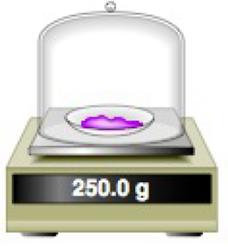
Bundle: Chemistry, Loose-Leaf Version, 10th + OWLv2, 4 terms (24 months) Printed Access Card
10th Edition
ISBN: 9781337537933
Author: Steven S. Zumdahl, Susan A. Zumdahl, Donald J. DeCoste
Publisher: Cengage Learning
expand_more
expand_more
format_list_bulleted
Concept explainers
Textbook Question
Chapter 2, Problem 5ALQ
You have a chemical in a sealed glass container filled with air. The setup is sitting on a balance as shown below. The chemical is ignited by means of a magnifying glass focusing sunlight on the reactant. After the chemical has completely burned, which of the following is true? Explain your answer.

- a. The balance will read less than 250.0 g.
- b. The balance will read 250.0 g.
- c. The balance will read greater than 250.0 g.
- d. Cannot be determined without knowing the identity of the chemical.
Expert Solution & Answer
Trending nowThis is a popular solution!

Students have asked these similar questions
What is the total energy cost associated with the compound below adopting the shown conformation?
CH3
HH
DH
CH3
ΗΝ,
Draw Final Product
C
cyclohexanone
pH 4-5
Edit Enamine
H3O+
CH3CH2Br
THF, reflux
H
Edit Iminium Ion
How many hydrogen atoms are connected to the indicated carbon atom?
Chapter 2 Solutions
Bundle: Chemistry, Loose-Leaf Version, 10th + OWLv2, 4 terms (24 months) Printed Access Card
Ch. 2 - Use Daltons atomic theory to account for each of...Ch. 2 - What evidence led to the conclusion that cathode...Ch. 2 - What discoveries were made by J. J. Thomson, Henri...Ch. 2 - Consider Ernest Rutherfords -particle bombardment...Ch. 2 - Do the proton and the neutron have exactly the...Ch. 2 - What is the distinction between atomic number and...Ch. 2 - Distinguish between the terms family and period in...Ch. 2 - The compounds AlCl3, CrCl3, and ICl3 have similar...Ch. 2 - Prob. 9RQCh. 2 - How would you name HBrO4, KIO3, NaBrO2, and HIO?...
Ch. 2 - Which of the following is true about an individual...Ch. 2 - How would you go about finding the number of chalk...Ch. 2 - These questions concern the work of J. J. Thomson....Ch. 2 - Prob. 4ALQCh. 2 - You have a chemical in a sealed glass container...Ch. 2 - The formula of water is If-O. Which of the...Ch. 2 - You may have noticed that when water boils, you...Ch. 2 - One of the best indications of a useful theory is...Ch. 2 - Prob. 9ALQCh. 2 - Label each of the following as an atomic element,...Ch. 2 - Why is the term sodium chloride molecule incorrect...Ch. 2 - Prob. 12ALQCh. 2 - Label each of the following as an atomic element,...Ch. 2 - Prob. 14ALQCh. 2 - Prob. 15ALQCh. 2 - Prob. 16ALQCh. 2 - Which of tire following explain how an ion is...Ch. 2 - What refinements had to be made in Daltons atomic...Ch. 2 - When hydrogen is burned in oxygen to form water,...Ch. 2 - The two most reactive families of elements are the...Ch. 2 - Explain the law of conservation of mass, the law...Ch. 2 - Section 2.3 describes the postulates of Daltons...Ch. 2 - The contributions of J. J. Thomson and Ernest...Ch. 2 - Prob. 24QCh. 2 - The number of protons in an atom determines the...Ch. 2 - If the volume of a proton were similar to the...Ch. 2 - Prob. 27QCh. 2 - List some characteristic properties that...Ch. 2 - Consider the elements of Group 4A (the carbon...Ch. 2 - Chlorine has two natural isotopes: 1737Cl and...Ch. 2 - Before an electrocardiogram (ECG) is recorded for...Ch. 2 - Distinguish between the following terms. a....Ch. 2 - Label the type of bonding for each of the...Ch. 2 - The vitamin niacin (nicotinic acid. C6H5NO2) can...Ch. 2 - Prob. 35QCh. 2 - Prob. 36QCh. 2 - When mixtures of gaseous H2 and gaseous Cl2 react,...Ch. 2 - Observations of the reaction between nitrogen gas...Ch. 2 - A sample of chloroform is found to contain 12.0 g...Ch. 2 - A sample of H2SO4 contains 2.02 g of hydrogen,...Ch. 2 - Consider 80.0-g samples of two different compounds...Ch. 2 - Several compounds containing sulfur and fluorine...Ch. 2 - The three most stable oxides of carbon ire carbon...Ch. 2 - Two elements. R and Q, combine to form two binary...Ch. 2 - In Section 1.1 of the text, the concept of a...Ch. 2 - In a combustion reaction, 46.0 g of ethanol reacts...Ch. 2 - Early tables of atomic weights (masses) were...Ch. 2 - Indium oxide contains 4.784 g of indium for every...Ch. 2 - Prob. 49ECh. 2 - If you wanted to make an accurate scale model of...Ch. 2 - In an experiment it was found that the total...Ch. 2 - A chemist in a galaxy tar, far away performed the...Ch. 2 - What are the symbols of the following nonmetals:...Ch. 2 - Prob. 55ECh. 2 - In the periodic table, how many elements are found...Ch. 2 - a. Classify the following elements as metals or...Ch. 2 - a. List the noble gas elements. Which of the noble...Ch. 2 - For each of the following sets of elements, label...Ch. 2 - Prob. 60ECh. 2 - Prob. 61ECh. 2 - Write the atomic symbol (ZAX) for each of the...Ch. 2 - Write the symbol of each atom using the ZAX...Ch. 2 - For carbon-14 and carbon-12, how many protons and...Ch. 2 - How many protons and neutrons are in the nucleus...Ch. 2 - Prob. 66ECh. 2 - For each of the following ions, indicate the...Ch. 2 - How many protons, neutrons, and electrons are in...Ch. 2 - Prob. 69ECh. 2 - What is the symbol of an ion with 16 protons, 18...Ch. 2 - Complete the following table: Symbol Number of...Ch. 2 - Complete the following table: Symbol Number of...Ch. 2 - Would you expect each of the following atoms to...Ch. 2 - Prob. 74ECh. 2 - Name the compounds in parts ad and write the...Ch. 2 - Name the compounds in parts a-d and write the...Ch. 2 - Prob. 77ECh. 2 - Prob. 78ECh. 2 - Prob. 79ECh. 2 - Prob. 80ECh. 2 - Prob. 81ECh. 2 - Prob. 82ECh. 2 - Prob. 83ECh. 2 - Prob. 84ECh. 2 - Prob. 85ECh. 2 - Prob. 86ECh. 2 - Prob. 87ECh. 2 - Write the formula for each of the following...Ch. 2 - Prob. 89ECh. 2 - Write the formula for each of the following...Ch. 2 - Prob. 91ECh. 2 - Each of the following compounds is incorrectly...Ch. 2 - Insulin is a complex protein molecule produced by...Ch. 2 - Carbohydrates, a class of compounds containing the...Ch. 2 - Prob. 95AECh. 2 - What are the symbols for the following nonmetal...Ch. 2 - Four Fe2+ ions are key components of hemoglobin,...Ch. 2 - Which of the following statements is(are) true?...Ch. 2 - The isotope of an unknown element, X, has a mass...Ch. 2 - Prob. 100AECh. 2 - Prob. 101AECh. 2 - Identify each of the following elements: a. a...Ch. 2 - Prob. 103AECh. 2 - Prob. 104AECh. 2 - Prob. 105AECh. 2 - Prob. 106AECh. 2 - Prob. 107AECh. 2 - Prob. 108AECh. 2 - Consider 100.0-g samples of two different...Ch. 2 - Give the systematic name for the following...Ch. 2 - Prob. 111CWPCh. 2 - Prob. 112CWPCh. 2 - Complete the following table. Atom/Ion Protons...Ch. 2 - Which of the following is{are) correct? a. 40Ca2...Ch. 2 - Prob. 115CWPCh. 2 - Prob. 116CWPCh. 2 - Prob. 117CWPCh. 2 - Prob. 118CWPCh. 2 - Reaction of 2.0 L of hydrogen gas with 1.0 L of...Ch. 2 - A combustion reaction involves the reaction of a...Ch. 2 - A chemistry instructor makes the following claim:...Ch. 2 - The early alchemists used to do an experiment in...Ch. 2 - Consider the chemical reaction as depicted below....Ch. 2 - Each of the following statements is true, but...Ch. 2 - You have two distinct gaseous compounds made from...Ch. 2 - A single molecule has a mass of 7.31 1023 g....Ch. 2 - You take three compounds, each consisting of two...Ch. 2 - Prob. 129IPCh. 2 - Prob. 130IPCh. 2 - Using the information in Table 2.1, answer the...
Knowledge Booster
Learn more about
Need a deep-dive on the concept behind this application? Look no further. Learn more about this topic, chemistry and related others by exploring similar questions and additional content below.Similar questions
- Identify the compound with the longest carbon - nitrogen bond. O CH3CH2CH=NH O CH3CH2NH2 CH3CH2C=N CH3CH=NCH 3 The length of all the carbon-nitrogen bonds are the samearrow_forwardIdentify any polar covalent bonds in epichlorohydrin with S+ and 8- symbols in the appropriate locations. Choose the correct answer below. Η H's+ 6Η Η Η Η Η Ηδ Η Ο Ο HH +Η Η +Η Η Η -8+ CIarrow_forwardH H:O::::H H H HH H::O:D:D:H HH HH H:O:D:D:H .. HH H:O:D:D:H H H Select the correct Lewis dot structure for the following compound: CH3CH2OHarrow_forward
- Rank the following compounds in order of decreasing boiling point. ннннн -С-С-Н . н-с- ННННН H ΗΤΗ НННН TTTĪ н-с-с-с-с-о-н НННН НН C' Н н-с-с-с-с-н НН || Ш НННН H-C-C-C-C-N-H ННННН IVarrow_forwardRank the following compounds in order of decreasing dipole moment. |>||>||| ||>|||>| |>|||>|| |||>||>| O ||>>||| H F H F H c=c || H c=c F F IIIarrow_forwardchoose the description that best describes the geometry for the following charged species ch3-arrow_forward
- Why isn't the ketone in this compound converted to an acetal or hemiacetal by the alcohol and acid?arrow_forwardWhat is the approximate bond angle around the nitrogen atom? HNH H Harrow_forwardOH 1. NaOCH2CH3 Q 2. CH3CH2Br (1 equiv) H3O+ Select to Draw 1. NaOCH2 CH3 2. CH3Br (1 equiv) heat Select to Edit Select to Drawarrow_forward
- Complete and balance the following half-reaction in acidic solution. Be sure to include the proper phases for all species within the reaction. S₂O₃²⁻(aq) → S₄O₆²⁻(aq)arrow_forwardQ Select to Edit NH3 (CH3)2CHCI (1 equiv) AICI 3 Select to Draw cat. H2SO4 SO3 (1 equiv) HO SOCl2 pyridine Select to Edit >arrow_forwardComplete and balance the following half-reaction in basic solution. Be sure to include the proper phases for all species within the reaction. Zn(s) → Zn(OH)₄²⁻(aq)arrow_forward
arrow_back_ios
SEE MORE QUESTIONS
arrow_forward_ios
Recommended textbooks for you
 Introductory Chemistry: A FoundationChemistryISBN:9781337399425Author:Steven S. Zumdahl, Donald J. DeCostePublisher:Cengage Learning
Introductory Chemistry: A FoundationChemistryISBN:9781337399425Author:Steven S. Zumdahl, Donald J. DeCostePublisher:Cengage Learning Chemistry: An Atoms First ApproachChemistryISBN:9781305079243Author:Steven S. Zumdahl, Susan A. ZumdahlPublisher:Cengage Learning
Chemistry: An Atoms First ApproachChemistryISBN:9781305079243Author:Steven S. Zumdahl, Susan A. ZumdahlPublisher:Cengage Learning General Chemistry - Standalone book (MindTap Cour...ChemistryISBN:9781305580343Author:Steven D. Gammon, Ebbing, Darrell Ebbing, Steven D., Darrell; Gammon, Darrell Ebbing; Steven D. Gammon, Darrell D.; Gammon, Ebbing; Steven D. Gammon; DarrellPublisher:Cengage Learning
General Chemistry - Standalone book (MindTap Cour...ChemistryISBN:9781305580343Author:Steven D. Gammon, Ebbing, Darrell Ebbing, Steven D., Darrell; Gammon, Darrell Ebbing; Steven D. Gammon, Darrell D.; Gammon, Ebbing; Steven D. Gammon; DarrellPublisher:Cengage Learning Chemistry by OpenStax (2015-05-04)ChemistryISBN:9781938168390Author:Klaus Theopold, Richard H Langley, Paul Flowers, William R. Robinson, Mark BlaserPublisher:OpenStax
Chemistry by OpenStax (2015-05-04)ChemistryISBN:9781938168390Author:Klaus Theopold, Richard H Langley, Paul Flowers, William R. Robinson, Mark BlaserPublisher:OpenStax Chemistry for Engineering StudentsChemistryISBN:9781337398909Author:Lawrence S. Brown, Tom HolmePublisher:Cengage Learning
Chemistry for Engineering StudentsChemistryISBN:9781337398909Author:Lawrence S. Brown, Tom HolmePublisher:Cengage Learning ChemistryChemistryISBN:9781305957404Author:Steven S. Zumdahl, Susan A. Zumdahl, Donald J. DeCostePublisher:Cengage Learning
ChemistryChemistryISBN:9781305957404Author:Steven S. Zumdahl, Susan A. Zumdahl, Donald J. DeCostePublisher:Cengage Learning

Introductory Chemistry: A Foundation
Chemistry
ISBN:9781337399425
Author:Steven S. Zumdahl, Donald J. DeCoste
Publisher:Cengage Learning

Chemistry: An Atoms First Approach
Chemistry
ISBN:9781305079243
Author:Steven S. Zumdahl, Susan A. Zumdahl
Publisher:Cengage Learning

General Chemistry - Standalone book (MindTap Cour...
Chemistry
ISBN:9781305580343
Author:Steven D. Gammon, Ebbing, Darrell Ebbing, Steven D., Darrell; Gammon, Darrell Ebbing; Steven D. Gammon, Darrell D.; Gammon, Ebbing; Steven D. Gammon; Darrell
Publisher:Cengage Learning

Chemistry by OpenStax (2015-05-04)
Chemistry
ISBN:9781938168390
Author:Klaus Theopold, Richard H Langley, Paul Flowers, William R. Robinson, Mark Blaser
Publisher:OpenStax

Chemistry for Engineering Students
Chemistry
ISBN:9781337398909
Author:Lawrence S. Brown, Tom Holme
Publisher:Cengage Learning

Chemistry
Chemistry
ISBN:9781305957404
Author:Steven S. Zumdahl, Susan A. Zumdahl, Donald J. DeCoste
Publisher:Cengage Learning
Types of Matter: Elements, Compounds and Mixtures; Author: Professor Dave Explains;https://www.youtube.com/watch?v=dggHWvFJ8Xs;License: Standard YouTube License, CC-BY